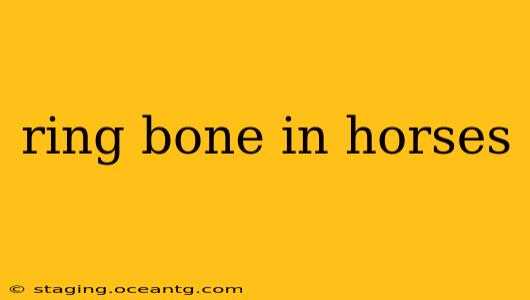Ringbone is a debilitating condition affecting horses, causing significant lameness and impacting their performance and overall well-being. This comprehensive guide delves into the causes, symptoms, diagnosis, treatment, and prevention of ringbone in horses, answering many frequently asked questions horse owners have about this condition. Understanding ringbone is crucial for horse owners to ensure prompt diagnosis and appropriate management, maximizing the horse's comfort and potential.
What is Ringbone in Horses?
Ringbone is a degenerative joint disease affecting the bones of the horse's fetlock joint (the joint above the fetlock), and sometimes the pastern joint (the joint below the fetlock). It's characterized by the formation of new bone, resulting in bony enlargements that often form a "ring" around the joint – hence the name. This new bone formation is a response to injury or repetitive stress on the joint, causing inflammation and pain. There are two main types:
- High ringbone: Affects the pastern joint.
- Low ringbone: Affects the fetlock joint.
Both types can cause lameness, ranging from mild to severe, depending on the severity of the bone formation and associated inflammation.
What Causes Ringbone in Horses?
The underlying cause of ringbone is often linked to repetitive stress and micro-trauma to the joints. Factors that can contribute to the development of ringbone include:
- Conformation: Horses with poor conformation, such as those with upright pasterns or other structural abnormalities, are more prone to ringbone.
- Strain: Excessive strain on the joints from strenuous work, jumping, or hard surfaces can lead to micro-fractures and inflammation.
- Genetics: A predisposition to ringbone may be inherited.
- Trauma: A significant injury, such as a fracture or severe sprain, can initiate the bone growth associated with ringbone.
Understanding these contributing factors can help horse owners implement preventative measures to reduce the risk.
What are the Symptoms of Ringbone in Horses?
The signs of ringbone can vary depending on its severity and location. Early symptoms may be subtle and easily overlooked. Common indicators include:
- Lameness: This can range from mild stiffness to severe lameness, particularly noticeable after exercise.
- Swelling: Hard, bony swellings are typically visible around the affected joint(s).
- Heat: The affected area may feel warm to the touch.
- Pain: The horse may exhibit pain when the joint is palpated or flexed.
- Stiffness: Reduced range of motion in the affected joint.
If you observe any of these symptoms, it's essential to consult a veterinarian promptly for a proper diagnosis and to discuss treatment options.
How is Ringbone in Horses Diagnosed?
Diagnosis is usually made through a thorough physical examination, including palpation of the affected joint to assess for swelling and pain. Additional diagnostic tools may include:
- Radiographs (X-rays): X-rays are vital for visualizing the bony changes characteristic of ringbone and determining its severity.
- Ultrasound: Ultrasound can help assess the soft tissue inflammation around the affected joint.
- Joint fluid analysis (arthrocentesis): This procedure involves aspirating fluid from the joint to analyze it for signs of infection or inflammation.
A comprehensive assessment by an equine veterinarian is crucial for accurate diagnosis and appropriate management of the condition.
How is Ringbone Treated in Horses?
Treatment approaches vary depending on the severity of the ringbone, the horse's age, and its intended use. Options may include:
- Rest: Complete rest is often crucial to allow the joint to heal and reduce inflammation.
- Non-steroidal anti-inflammatory drugs (NSAIDs): NSAIDs help reduce pain and inflammation.
- Joint injections: Corticosteroids or hyaluronic acid may be injected into the affected joint to reduce inflammation and improve joint lubrication.
- Surgery: In severe cases, surgery may be necessary to remove bone spurs or fuse the joint. This is often a last resort.
- Farrier adjustments: Proper shoeing and trimming can help reduce stress on the affected joint.
The veterinarian will tailor a treatment plan to the individual horse's needs and circumstances.
Can Ringbone in Horses Be Prevented?
While ringbone can't always be prevented, taking steps to minimize risk factors can be beneficial. These preventative measures include:
- Careful breeding: Selecting horses with sound conformation can reduce the risk of ringbone.
- Appropriate exercise: Avoiding overexertion and ensuring gradual conditioning can help minimize stress on the joints.
- Good hoof care: Maintaining healthy hooves and proper shoeing reduces the risk of abnormal stress on the joints.
- Suitable surfaces: Providing horses with well-maintained footing reduces the risk of injury and repetitive micro-trauma.
What is the Prognosis for Horses with Ringbone?
The prognosis for horses with ringbone depends on several factors, including the severity of the condition, the location of the lesion, and the treatment implemented. Mild cases may respond well to conservative management, allowing the horse to return to its previous activity level. Severe cases, however, may result in permanent lameness, limiting the horse's ability to perform its intended function. Regular veterinary care and monitoring are essential for managing the condition and optimizing the horse's long-term well-being.
This information is for educational purposes only and should not be considered a substitute for professional veterinary advice. If you suspect your horse has ringbone, consult a qualified equine veterinarian immediately for proper diagnosis and treatment.
